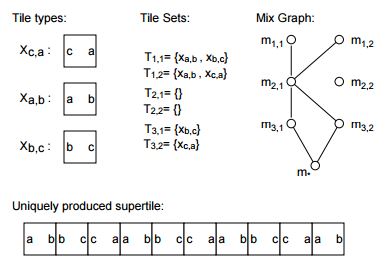Staged Tile Assembly Model
Jump to navigation
Jump to search
Overview
The staged self-assembly model is a generalization of the two-handed or hierarchical tile self-assembly models. The staged model extends the two-handed model by carrying out separate assembly processes in multiple bins. Assembly in each bin begins with input assemblies previously assembled in other bins. These bins are stratified into stages, and a mix graph specifies which bins in the previous stage supply each bin with input assemblies. The output of a staged self-assembly system is the set of assemblies produced in the bins of the final stage. [1]
An example of a staged assembly system. This system uniquely produces a \(1\times10\) line. The tile, stage, and bin complexities are 3, 3, and 2, respectively.[2]
References
- ↑
Cameron Chalk, Eric Martinez, Robert Schweller, Luis Vega, Andrew Winslow,, Tim Wylie - Optimal Staged Self-Assembly of General Shapes
- ↑
Erik D. Demaine, Martin L. Demaine, S´andor P. Fekete, Mashhood Ishaque, Eynat Rafalin, Robert T. Schweller,, Diane L. Souvaine - Staged Self-Assembly: Nanomanufacture of Arbitrary Shapes with O(1) Glues

